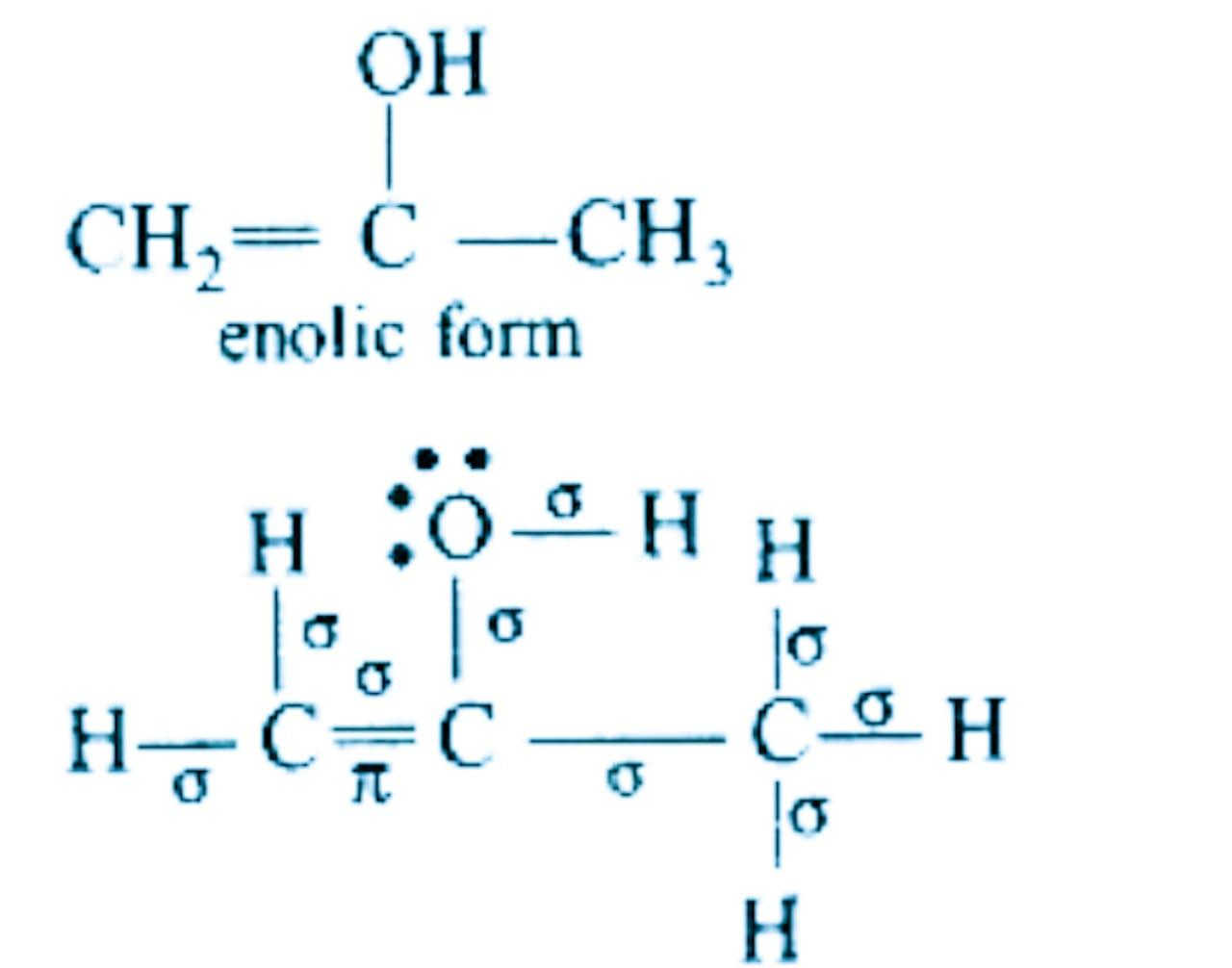
The enolic form of acetone contains: -
(a)- \[10\sigma -bonds\text{ }2\pi -bonds\text{ }and\text{ }1\text{ }lonepair\]
(b)- \[9\sigma -bonds\text{ }2\pi -bonds\text{ }and\text{ 2 }lonepairs\]
(c)- \[8\sigma -bonds\text{ }2\pi -bonds\text{ }and\text{ 2 }lonepairs\]
(d)- \[9\sigma -bonds\text{ 1}\pi -bond\text{ }and\text{ 2 }lonepairs\]
Answer
142.8k+ views
Hint: For the enolic form, the oxy group changes to the hydroxyl group. The double bond shifts from carbon-carbon to carbon-oxygen. Enolic form occurs because of a special type of bonding.
Complete step by step answer:
In simple aldehydes and ketones like acetaldehyde, acetone, etc., the amount of enolic form is negligibly small. However, if the enolic form is stabilized by intramolecular hydrogen bonding or resonance, the amount of enolic form is much greater than the keto form.
In acetone, the enolic form is stabilized by intramolecular hydrogen-bonding.
The formula of acetone is \[C{{H}_{3}}-CO-C{{H}_{3}}\]
It is the ketonic form.
The formula of the enolic form of acetone is \[C{{H}_{2}}=C(OH)-C{{H}_{3}}\].
The occurrence of keto-enol form is because of tautomerism. It is a special kind of functional isomerism in which the isomers exist in dynamic equilibrium with each other. It arises due to the migration of a hydrogen atom from one polyvalent atom to the other within the same molecule with the necessary rearrangement of linkages. The isomers obtained are called tautomers.

In the compound above there are \[9\sigma -bonds\].
There is \[\text{1}\pi -bond\], which has shifted from carbon-oxygen double bond in keto form to carbon-carbon double in enol form.
There are 2 lone pairs on the oxygen atom.
Hence, the correct option is (d)- \[9\sigma -bonds\text{ 1}\pi -bond\text{ }and\text{ 2 }lonepairs\].
Note: You may get confused between ketonic and enolic form. While converting ketonic to enolic form or vice-versa the valency of each atom should be checked and completed, to avoid the mistake.
Complete step by step answer:
In simple aldehydes and ketones like acetaldehyde, acetone, etc., the amount of enolic form is negligibly small. However, if the enolic form is stabilized by intramolecular hydrogen bonding or resonance, the amount of enolic form is much greater than the keto form.
In acetone, the enolic form is stabilized by intramolecular hydrogen-bonding.
The formula of acetone is \[C{{H}_{3}}-CO-C{{H}_{3}}\]
It is the ketonic form.
The formula of the enolic form of acetone is \[C{{H}_{2}}=C(OH)-C{{H}_{3}}\].
The occurrence of keto-enol form is because of tautomerism. It is a special kind of functional isomerism in which the isomers exist in dynamic equilibrium with each other. It arises due to the migration of a hydrogen atom from one polyvalent atom to the other within the same molecule with the necessary rearrangement of linkages. The isomers obtained are called tautomers.

In the compound above there are \[9\sigma -bonds\].
There is \[\text{1}\pi -bond\], which has shifted from carbon-oxygen double bond in keto form to carbon-carbon double in enol form.
There are 2 lone pairs on the oxygen atom.
Hence, the correct option is (d)- \[9\sigma -bonds\text{ 1}\pi -bond\text{ }and\text{ 2 }lonepairs\].
Note: You may get confused between ketonic and enolic form. While converting ketonic to enolic form or vice-versa the valency of each atom should be checked and completed, to avoid the mistake.
Recently Updated Pages
How to find Oxidation Number - Important Concepts for JEE

How Electromagnetic Waves are Formed - Important Concepts for JEE

Electrical Resistance - Important Concepts and Tips for JEE

Average Atomic Mass - Important Concepts and Tips for JEE

Chemical Equation - Important Concepts and Tips for JEE

Concept of CP and CV of Gas - Important Concepts and Tips for JEE

Trending doubts
JEE Main 2025 Session 2: Application Form (Out), Exam Dates (Released), Eligibility, & More

JEE Main Exam Marking Scheme: Detailed Breakdown of Marks and Negative Marking

JEE Main 2025: Derivation of Equation of Trajectory in Physics

Electric Field Due to Uniformly Charged Ring for JEE Main 2025 - Formula and Derivation

Types of Solutions

Degree of Dissociation and Its Formula With Solved Example for JEE

Other Pages
JEE Advanced Marks vs Ranks 2025: Understanding Category-wise Qualifying Marks and Previous Year Cut-offs

JEE Advanced 2025: Dates, Registration, Syllabus, Eligibility Criteria and More

NCERT Solutions for Class 11 Chemistry Chapter 5 Thermodynamics

JEE Advanced Weightage 2025 Chapter-Wise for Physics, Maths and Chemistry

Hydrocarbons Class 11 Notes: CBSE Chemistry Chapter 9

NCERT Solutions for Class 11 Chemistry In Hindi Chapter 1 Some Basic Concepts of Chemistry




